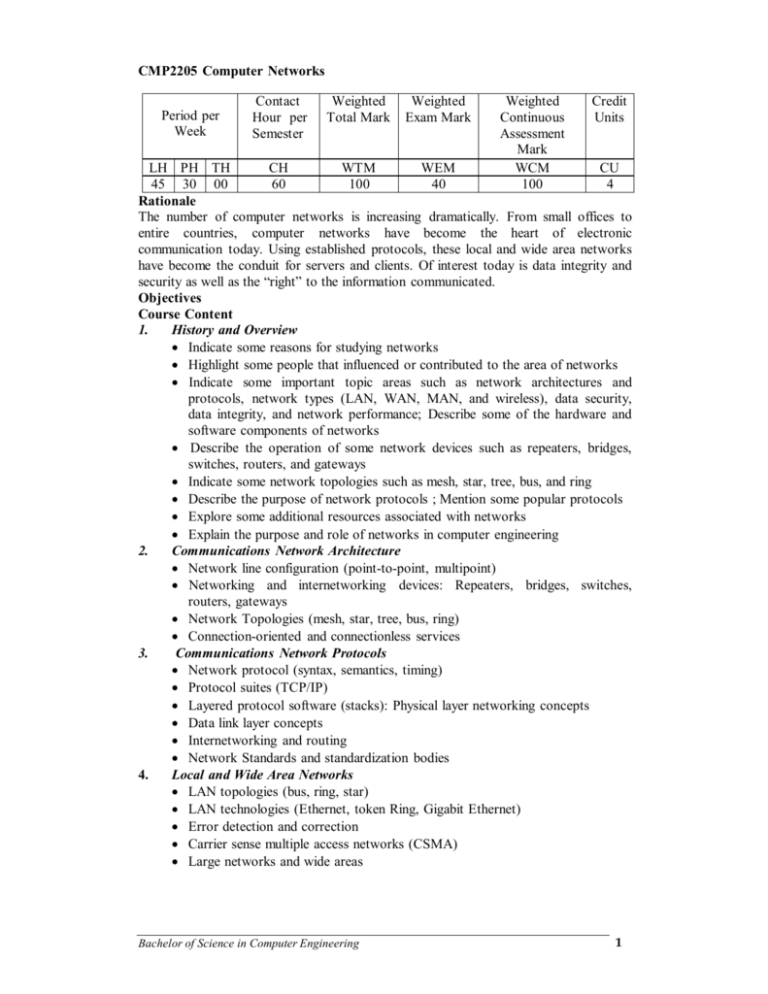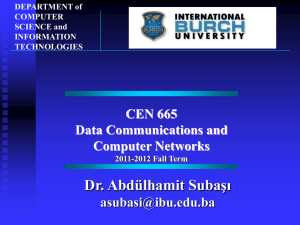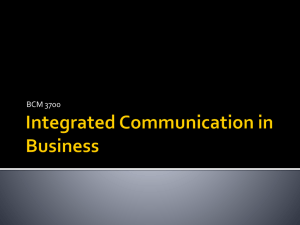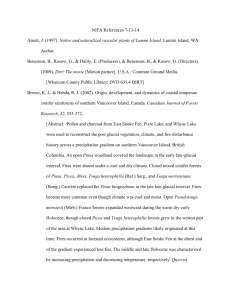CMP2205 Computer Networks
advertisement

CMP2205 Computer Networks Period per Week Contact Hour per Semester Weighted Total Mark Weighted Exam Mark Weighted Continuous Assessment Mark WCM 100 Credit Units LH PH TH CH WTM WEM CU 45 30 00 60 100 40 4 Rationale The number of computer networks is increasing dramatically. From small offices to entire countries, computer networks have become the heart of electronic communication today. Using established protocols, these local and wide area networks have become the conduit for servers and clients. Of interest today is data integrity and security as well as the “right” to the information communicated. Objectives Course Content 1. History and Overview Indicate some reasons for studying networks Highlight some people that influenced or contributed to the area of networks Indicate some important topic areas such as network architectures and protocols, network types (LAN, WAN, MAN, and wireless), data security, data integrity, and network performance; Describe some of the hardware and software components of networks Describe the operation of some network devices such as repeaters, bridges, switches, routers, and gateways Indicate some network topologies such as mesh, star, tree, bus, and ring Describe the purpose of network protocols ; Mention some popular protocols Explore some additional resources associated with networks Explain the purpose and role of networks in computer engineering 2. Communications Network Architecture Network line configuration (point-to-point, multipoint) Networking and internetworking devices: Repeaters, bridges, switches, routers, gateways Network Topologies (mesh, star, tree, bus, ring) Connection-oriented and connectionless services 3. Communications Network Protocols Network protocol (syntax, semantics, timing) Protocol suites (TCP/IP) Layered protocol software (stacks): Physical layer networking concepts Data link layer concepts Internetworking and routing Network Standards and standardization bodies 4. Local and Wide Area Networks LAN topologies (bus, ring, star) LAN technologies (Ethernet, token Ring, Gigabit Ethernet) Error detection and correction Carrier sense multiple access networks (CSMA) Large networks and wide areas Bachelor of Science in Computer Engineering 1 Circuit switching and packet switching Protocols (addressing, congestion control, virtual circuits, quality of service) 5. Client-Server Computing Web technologies: Server-side programs Common gateway interface (CGI) programs Client-side scripts The applet concept Characteristics of web servers: Handling permissions File management Capabilities of common server architectures Support tools for web site creation and web management 6. Data Security and Integrity Fundamentals of secure networks Cryptography Encryption and privacy: Public key, private key, symmetric key Authentication protocols Packet filtering Firewalls Virtual private networks Transport layer security 7. Wireless and Mobile Computing Overview of the history, evolution, and compatibility of wireless standards The special problems of wireless and mobile computing Wireless local area networks and satellite-based networks Mobile Internet protocol Mobile aware adaptation Extending the client-server model to accommodate mobility Mobile data access: server data dissemination and client cache management The software packages to support mobile and wireless computing The role of middleware and support tools Performance issues Emerging technologies 8. Performance Evaluation Privacy and public networks Virtual private networks Service paradigms: connection-oriented service Connectionless service Network performance characteristics: delay, throughput 9. Data Communications Encoding and modulating: A/D and D/A conversion Interfaces and modems Transmission media Multiplexing Error detection and correction 10. Network Management Overview of the issues of network management Use of passwords and access control mechanisms Bachelor of Science in Computer Engineering 2 Domain names and name services Issues for Internet service providers (ISPs) Security issues and firewalls Quality of service issues: performance, failure recovery 11. Compression and Decompression Analog and digital representations Encoding and decoding algorithms Lossless and lossy compression Data compression: Huffman coding and the Ziv-Lempel algorithm Audio compression and decompression Image compression and decompression Video compression and decompression Performance issues: timing, compression factor, suitability for real-time use Learning Outcomes Identify some contributors to networks and relate their achievements to the knowledge area; identify some components of a network; name some network devices and describe their purpose; describe advantages of a star topology over a ring topology; describe advantages of a ring topology over a star topology; define the meaning of a protocol; explain the importance of security when dealing with networks; and describe how computer engineering uses or benefits from networks. Understand fundamental concepts of networks and their topologies; and understand the concept of network architecture and its hardware components. Demonstrate understanding of the elements of a protocol, and the concept of layering; recognize the importance of networking standards, and their regulatory committees; describe the seven layers of the OSI model; compare and contrast the OSI model with the TCP/IP model; and demonstrate understanding of the differences between circuit switching and packet switching. Understand the basic concepts of LAN and WAN technologies and topologies; demonstrate understanding of different components and requirements of network protocols; demonstrate understanding of basic concepts of error detection and correction at the data link layer and below; and design and build a simple network by implementing (and designing) a simple network protocol that operates at the physical and data link layers of the OSI model. Explain the different roles and responsibilities of clients and servers for a range of possible applications; select a range of tools that will ensure an efficient approach to implementing various client-server possibilities; and design and build a simple interactive web-based application (e.g., a simple web form that collects information from the client and stores it in a file on the server). Understand common barriers to network security and the major issues involved in implementing proper security measures; describe the purpose of encryption and the function of public and private keys; compare and contrast the various types of firewalls; generate and distribute a PGP key pair and use the PGP package to send an encrypted e-mail message; and explain the concept of and necessity for transport layer security. Describe the main characteristics of mobile IP and explain how differs from IP with regard to mobility management and location management as well as performance; illustrate (with home agents and foreign agents) how e-mail and other traffic is routed using mobile IP; be aware of the many areas of interest that Bachelor of Science in Computer Engineering 3 lie within this area, including networking, multimedia, wireless, and mobile computing, and distributed computing. Define performance metric; and describe how each affects a particular network and/or service paradigm. Demonstrate understanding of the fundamental concepts of data communications; understand signals and signal encoding methods to communication service methods and data transmission modes. Explain the issues for network management arising from a range of security threats, including viruses, worms, Trojan horses, and denial-of-service attack; summarize the strengths and weaknesses associated with different approaches to security; develop a strategy for ensuring appropriate levels of security in a system designed for a particular purpose; and implement a network firewall. Summarize the basic characteristics of sampling and quantization for digital representation. Select, giving reasons that are sensitive to the specific application and particular circumstances, the most appropriate compression techniques for text, audio, image, and video information; explain the asymmetric property of compression and decompression algorithms; illustrate the concept of run-length encoding; and illustrate how a program like the UNIX compress utility, which uses Huffman coding and the ZivLempel algorithm, would compress a typical text file. Recommended and Reference Books [1] Andrew S. Tanenbaum1996. Computer Networks. Prentice Hall; 3rd Edition. ISBN-10: 0133499456, ISBN-13: 978-0133499452 [2] James F. Kurose and Keith W, 2007.Computer Networking: A Top-Down. Addison Wesley; 4 Edition. ISBN-10: 0321497708, ISBN-13: 9780321497703 [3] Natalia Olifer and Victor Olifer, 2006. Computer Networks: Principles, Technologies and Protocols for Network Design. Wiley. ISBN-10: 0470869828, ISBN-13: 978-0470869826 [4] Douglas E. Comer, 2003. Computer Networks and Internets with Internet Applications. 4th Edition. Prentice Hall. ISBN-10: 0131433512, ISBN-13: 978-0131433519 [5] Larry L. Peterson, Bruce S. Davie, 2007.Computer Networks: A Systems Approach, Fourth Edition (The Morgan Kaufmann Series in Networking). Morgan Kaufmann; 4 Edition. ISBN-10: 0123705487, ISBN-13: 9780123705488 [6] Nader F. Mir, 2006. Computer and Communication Networks. Prentice Hall PTR; 1 Edition . ISBN-10: 0131747991, ISBN-13: 978-0131747999 Bachelor of Science in Computer Engineering 4











